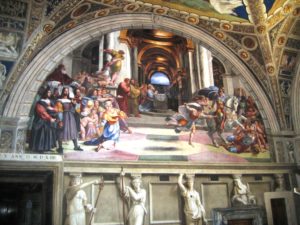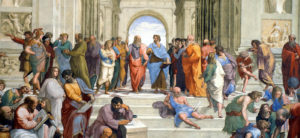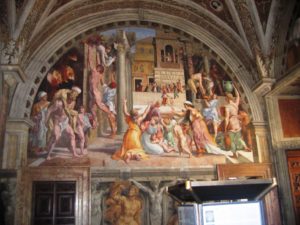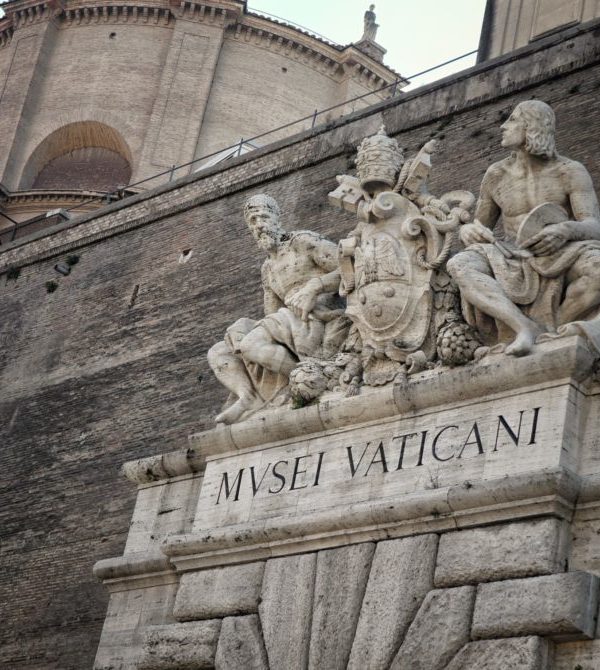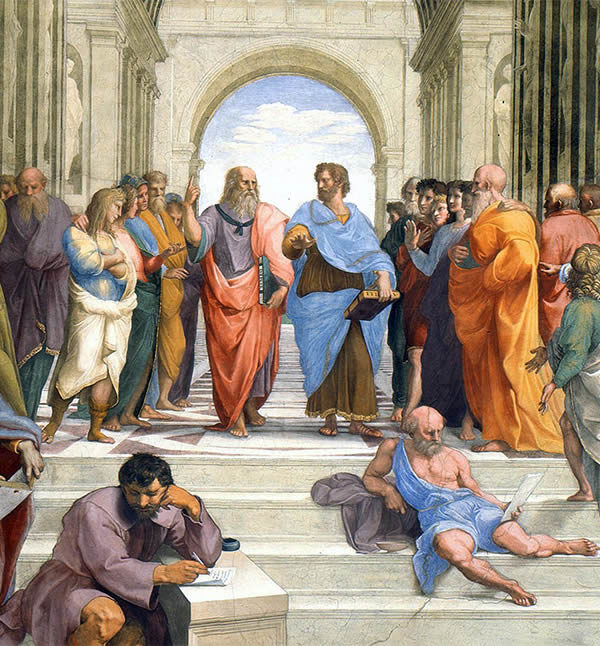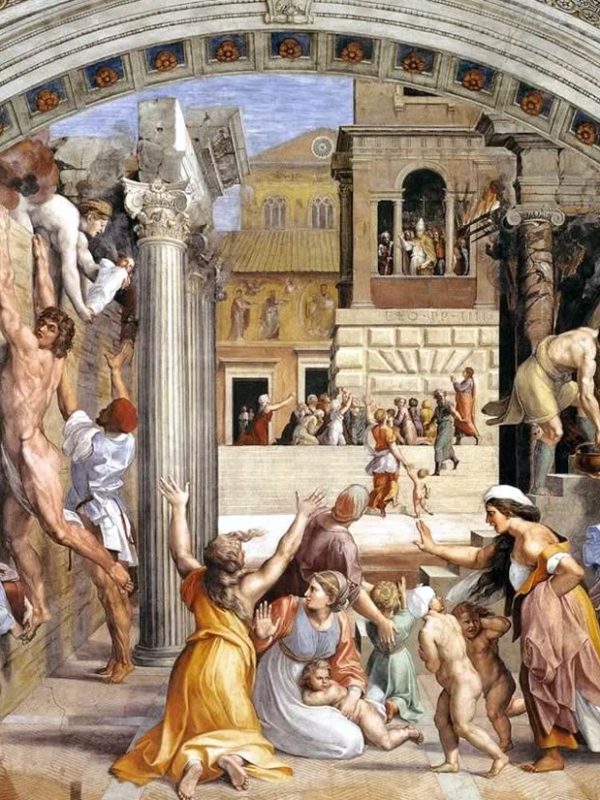The “Vatican Rooms” (Stanze vaticane) constituted the apartments of Pope Julius II (1503-1513), who, not wishing to live in the rooms used by his predecessor Alexander VI and already frescoed by Pinturicchio, had moved to the upper floor, in the wing built by Niccolò V in the mid-fifteenth century.
Here, artists much more successful than him, such as Perugino, his master, had already worked here, but Raffaello Sanzio (1483-1520), left free by Pope Julius II to conduct the frescoes as he liked, canceled what was done.
The rooms were painted in the following chronological order: Room of the Segnatura 1508-1511, Room of Heliodorus 1511-1514, Room of the Borgo Fire 1514-1517, Room of Constantine 1517-1524.
The order of the visit will be taken into account in the exhibition with an obligatory path.
The Sala di Costantino was largely built by Raphael’s pupils, being the master who died suddenly on April 6, 1520.
Among the most important painters of the cycle we remember Giulio Romano and Francesco Penni. The episodes narrated are: the “Baptism of Constantine” in the Basilica of San Giovanni in Laterano, to the right of the current entrance; the “Apparition of the Cross to Constantine” opposite; then, in the wall in front of the windows, the “Battle of Ponte Milvio”, in which Constantine, according to tradition, saw the cross that announced the Basilica of San Pietro appear), an act that would have given rise to the State of the Church (in reality , this was born in 756 with the famous donation of lands of Central Italy by Pipino, king of the Franks, to the Holy See).
The ceiling, decorated by the painter Tommaso Laureti in 1585, represents the “Triumph of Christianity” against paganism, symbolized by the broken statue on the ground.
We then move on to the oldest, thirteenth-century nucleus of the Papal Palace; the Sala dei Chiaroscuri, frescoed on drawings by Raphael in the second decade of the sixteenth century, and the Niccolina Chapel, the private place of prayer of Pope Niccolò V, painted from 1447 to 1451 by the work of Beato Angelico, a Dominican friar dedicated to the art of miniature, who illustrated here the Stories of Santo Stefano and San Lorenzo.
Returning to the path of Raphael’s Rooms, we find ourselves in the Stanza di Eliodoro, the second to be performed by the artist from Urbino Raffaello between 1511 and 1514. Here the spiritual and temporal power of the Church is enhanced, with God’s interventions in favor some men. The “Mass of Bolsena” represents the miracle that occurred, according to tradition, in 1263 when drops of blood flowed from a host convincing a Bohemian priest of the veracity of the transubstantiation (transformation) of bread in the body of Christ and of the wine in his blood . Note the presence of the commissioning pope, Julius II, who attends mass.
The “Expulsion of Heliodorus” from the temple in Jerusalem wants to demonstrate the inviolability of the Church’s heritage: Heliodorus, who had stolen the treasure of the Jewish temple in Jerusalem, is joined by divine messengers while a group of people, including Julius II himself , attends the scene; compared to the “School of Athens” which will be seen later, the center of the empty painting and the dark colors are certainly influenced by contemporary Venetian painting. Also in the “Liberation of San Pietro dal Carcere” we find shades like the previous ones; it is one of the first nightspots in the history of Italian art. The fresco is divided into three episodes: the angel who appears in San Pietro and invites him to follow him (in the center), the escape of San Pietro and the angel (on the right), and the awakening of the guards in the background of a magnificent moonlight (left).
The “Room of the Signatura” follows, the first painted by Raphael.
The name derives from the function of this environment, intended for the papal library where official documents were signed. The three neo-Platonic categories of True, Good and Beautiful are represented here. The supernatural True is represented in the “Dispute of the Blessed Sacrament”, the rational one in the “School of Athens”, the Good in the representations of the “Virtues” and the “Law”, while the Beautiful in the “Parnassus”.
The “Dispute of the Blessed Sacrament” represents at the bottom, on the sides of an altar with the monstrance, two wings of ecclesiastical characters who “discuss” about the “truths” that are in heaven; high up, arranged in a semicircle on an exedra of clouds, saints and prophets sit conversing with each other in peace, because they have now been able to see what was promised on earth in heaven. Above is Christ, surrounded by the Madonna and Saint John, dominated by the God the Father, while at the foot is the dove, symbol of the Holy Spirit. The perspective of the floor has its vanishing point in the monstrance, the focal element of the composition.
The “School of Athens” is one of Raphael’s most famous paintings: against the background of an ancient architecture, probably a symbol of the new San Pietro Bramante, there are: in the center, Plato, with the appearance of Leonardo, who points his finger at heaven alluding to the world of ideas and Aristotle, who, turning his palm towards the ground, indicates, on the contrary, the rationalist principle of his philosophy. The two great protagonists of ancient thought are surrounded by a multitude of philosophers with the appearance of men of the time, including in the foreground Heraclitus (Michelangelo), Euclid (Bramante) who draws a geometric figure on the blackboard, Diogenes almost lying on the steps, Ptolemy and Zoroaster holding the globe and the celestial sphere respectively. The second character on the right with the green cap is Raphael’s self-portrait.
In the “Parnassus” Apollo, surrounded by muses, and famous poets and writers are represented. You can recognize, among others, on the left, Homer who turns his face to the sky, and Dante, portrait in profile.
In the last room painted on commission by Leone X Medici (1513-1521) and which takes its name from the main painting, the great historical events which took place under the popes named Leone are represented: the “Incendio di Borgo” depicts the miraculous intervention of Pope Leo IV in 847 who, looking out the window of the Loggia delle Benedizioni, caused the extinction, with the sign of the cross, of a grandiose fire that developed in the neighborhood around the Vatican Basilica. The other frescoes are the “Oath of Leo III”, the “Coronation of Charlemagne” by Pope Leo III in the year 800, as well as the “Battle of Ostia” victoriously conducted by Leo IV against the Saracens, held on the Roman coast in 849: all the frescoes are the help of the great Raphael.
The construction of the “Lodges” began in 1508 by the architect Donato Bramante; at his death (1514) the works continued under the direction of Raphael, to whom the frescoes on the second floor are also due.
These, created thanks to the collaboration of his students, constitute the pictorial response to his rival Michelangelo, to such an extent that the artist reproposed for the most part the same themes of Genesis in the Sistine Chapel.
The frescoes on the first and third floors are by the 16th century painters Giovanni da Udine, Giulio Romano and Perin del Vaga.
Note in particular the “grotesque” decorations, characterized by plant motifs mixed with bizarre human or animal figures, made inspired by the paintings of the newly discovered Domus Aurea, residence of the emperor Nero (54-64 AD).

